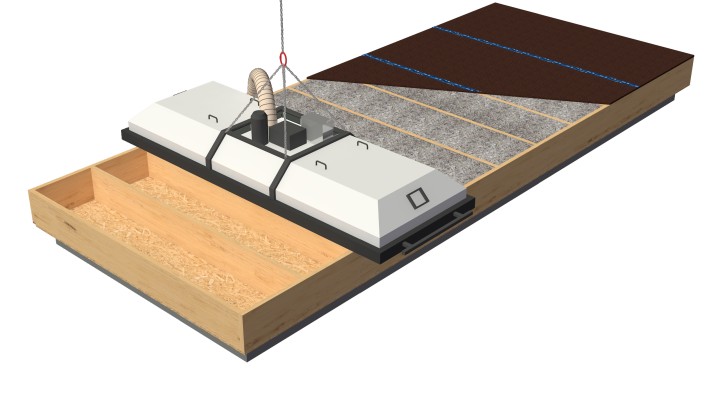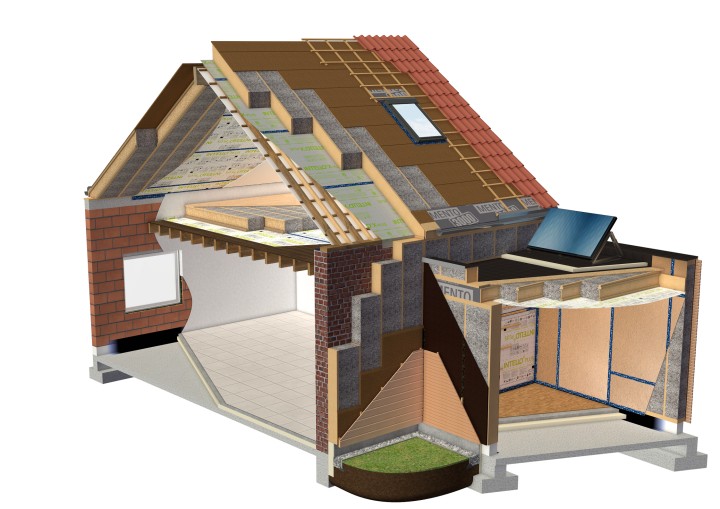Prefab timber construction
Prefab timber frame construction is rapidly gaining popularity as a sustainable and efficient building method.
By combining high-quality prefab production, shorter construction times, and a lower ecological footprint, prefab timber frame construction meets the growing demand for energy-efficient and quickly realizable homes. This emerging technique offers an innovative response to both the housing crisis and the increasingly strict environmental requirements in the construction sector.
ISOPROC’s range is also tailored to prefab (timber frame) construction.
The text on this page was automatically translated. Minor translation errors may occur. In case of doubt, the original Dutch and French versions are considered correct.
The advantages of prefab timber construction at a glance
- Fast construction time: The prefab elements are pre-produced in a factory, resulting in a shorter on-site construction time.
- Sustainability: Wood is a renewable and eco-friendly building material, contributing to a lower ecological footprint.
- Energy efficiency: Timber frame construction provides excellent thermal insulation, helping to save energy and lower utility bills.
- Lightweight construction: Wood is lighter than traditional materials like concrete, making it easier to handle and requiring less heavy-duty foundations.
- Cost savings: Thanks to the prefab process, construction costs can be better controlled, with less waste and lower on-site labor costs.
- Design flexibility: Prefab timber frame construction offers great design freedom and customization options, suitable for both modern and traditional styles.
- Less construction waste: Prefab construction generates less waste, as components are precisely manufactured in a controlled environment.
- Fewer construction delays: Only during the brief on-site assembly phase can weather conditions cause delays, contributing to a streamlined process.
- Vapor-open structure: Combined with wood, our materials allow for vapor-open construction, which promotes moisture regulation and results in a safe building method.
What does our prefab timber construction solution consist of?
There’s one principle we at ISOPROC always advocate across all solutions: good insulation is more than just a thick layer of insulating material!
Wind, temperature differences, and mechanical ventilation cause pressure differences between the inside and outside of a building. Even the smallest cracks or holes in the building envelope allow uncontrolled air exchange. This short-circuits the insulation. In winter, this can lead to energy and comfort loss, condensation issues, mold, and impaired ventilation performance. In summer, the same uncontrolled airflows increase the risk of overheating.
To insulate effectively, it is therefore just as important to build airtight and windtight. This principle is central to all our solutions.
Products used
Via the link below, you’ll find a selection of our product and machine range for:
This will get you started right away.
Our support
A detailed document with sketches, background info, and installation details is not yet available. But we won’t leave you empty-handed.
Helpdesk
Our products are perfectly suited for “prefab timber construction.” The specialists on our technical helpdesk are fully versed in the topic.
So don’t hesitate to contact our free technical helpdesk. We’re happy to share our expertise and knowledge.
Additional note: Why is iQ3 cellulose ideal as an insulation material for prefab timber construction?
- Excellent thermal performance: iQ3 cellulose has a high insulation value, helping to keep heat in during the winter and out during the summer. This boosts the energy efficiency of timber frame homes.
- Sustainable and environmentally friendly: Cellulose insulation is made from recycled paper, making it a very sustainable choice. This aligns perfectly with the environmentally friendly aspects of timber frame construction.
To assess environmental impact, it's best to use an analysis in TOTEM. TOTEM is a tool jointly developed by the three Belgian regions that objectively compares the total environmental impact of building components. In addition to energy use over a 60-year lifespan, TOTEM also considers the overall impact (CO₂ and nitrogen emissions, energy, water and resource consumption, ozone impact, and many other factors) of materials, from raw material extraction to building demolition. - Good acoustic insulation: iQ3 cellulose not only insulates against heat loss but also provides excellent sound dampening, creating a quiet and comfortable indoor environment.
- Perfectly fills every space: Because cellulose insulation is blown in, it fills cavities in prefab walls quickly and completely, leaving no gaps or thermal bridges—even in complex compartments. And this without any cutting waste. This ensures optimal insulation in the compact structure of timber frame buildings.
- Fire safety: iQ3 cellulose is treated with fire-retardant minerals, making it a safe choice—even in a timber construction—by reducing the risk of rapid fire spread.
- Moisture regulation: Cellulose has a vapor-open and hygroscopic nature, meaning it can absorb and release moisture without losing its insulating properties. This prevents moisture problems and mold formation in timber frame buildings.


